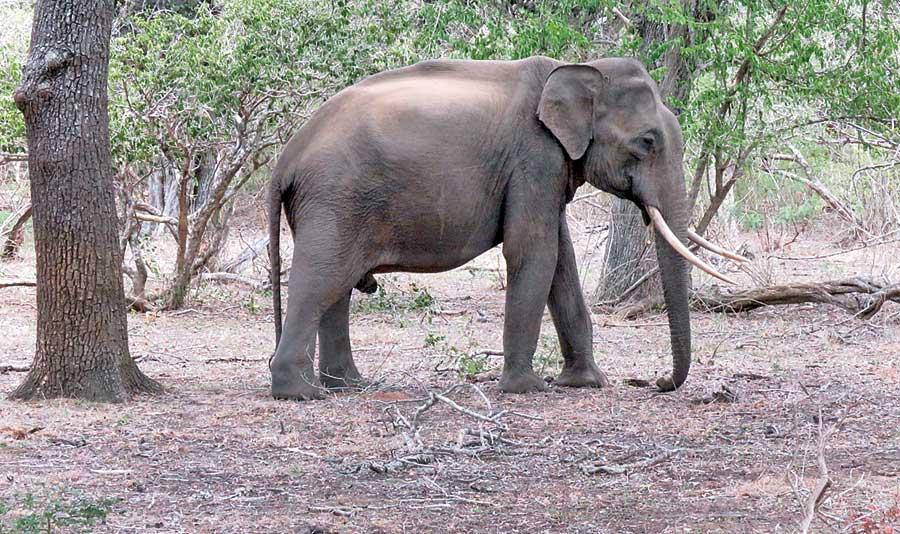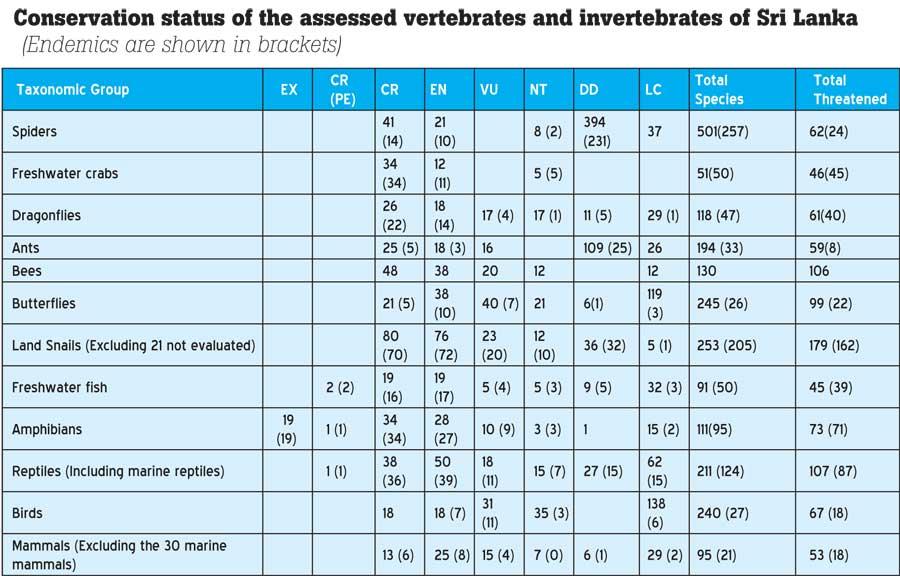Reply To:
Name - Reply Comment
- A few days after Dr Pilapitiya’s resignation officials of the Department of Wildlife had said that every Director General of Wildlife and even wildlife officials were subject to immense political pressure.
- Most of the conservationists contacted were of the view that Sri Lanka’s wildlife could be conserved even at this late stage President Gotabaya Rajapaksa should take up the challenge

Elephant at Yala National Park (Endangered)
The Wildlife Department was established in October 1949 but the first attempt to stop the destruction of Sri  Lanka’s wildlife resources was made in 1889, by the Conservator of Forests and the biggest challenge the Department of Wildlife Conservation has been facing from 1960 onwards was to ensure the protection of wildlife resources against the large scale multipurpose development projects implemented in the country.
Lanka’s wildlife resources was made in 1889, by the Conservator of Forests and the biggest challenge the Department of Wildlife Conservation has been facing from 1960 onwards was to ensure the protection of wildlife resources against the large scale multipurpose development projects implemented in the country.
‘The National Red List of Threatened Fauna and Flora 2012’ published by the Biodiversity Secretariat of the Ministry of Environment 52 years later stands proof of the ultimate victor with 534 of the 980 species of mammals, birds, reptiles, amphibians, freshwater fish, freshwater crabs, land snails, butterflies, dragonflies, ants and spiders endemic to Sri Lanka being classified as nationally threatened while 228 of the 534 species are classified as Critically Endangered.
It is still not too late for the decision makers to take note and ensure that the Department of Wildlife Conservation (DWLC) fulfills its mission statement, “To conserve wildlife and nature by the sustainable utilization of men, material and land through participatory management, research, education and law enforcement and ensure the maintenance of biodiversity and forest cover as exist today”.

The IUCN Red List Categories (Source: www.redlist.org)
‘The National Red List of Threatened Fauna and Flora 2012’ shows that almost 86% of Sri Lanka’s endemic  mammals, 67% of the endemic birds , 70% of the endemic reptiles, 75% of the endemic amphibians and 78% of the endemic species of freshwater fish are listed as threatened while 228 endemic species are listed as Critically Endangered! Furthermore, 19 species of endemic amphibians are believed to be extinct and there is little doubt how the numbers would read in years to come if the issue is not addressed immediately.
mammals, 67% of the endemic birds , 70% of the endemic reptiles, 75% of the endemic amphibians and 78% of the endemic species of freshwater fish are listed as threatened while 228 endemic species are listed as Critically Endangered! Furthermore, 19 species of endemic amphibians are believed to be extinct and there is little doubt how the numbers would read in years to come if the issue is not addressed immediately.
The species of mammals named as critically endangered include the Golden Dry Zone palm civet, Hog deer (Vil muwa or Gona muwa) and several species of shrews, bat, rats and mice. With a population of less than a thousand in the wild and deaths recorded on the rise the Sri Lankan leopard (Panthera Pardus Kotiya) and its close relative the Fishing Cat (Handun Diviya) may be on the list in the near future and so would even the Sri Lankan Elephant with an estimated population of around 6,000 is classified as endangered with more than 400 elephant deaths being reported in 2019 alone.
Co-editor of the report, Professor Devaka Weerakoon of the University of Colombo states that Sri Lanka, with a total land area of 65,610 square kilometres has the highest species density (number of species present per 10,000 sq. km) for flowering plants, amphibians, reptiles, and mammals in the Asian region and added that the high biodiversity seen in Sri Lanka can be attributed to a wide variety of climatic, topographic and soil conditions that exist in the island that has resulted in a diverse array of aquatic and terrestrial habitats. He also says that the southwestern region of Sri Lanka, encompassing approximately 20,000 km2, referred to as the wet zone of Sri Lanka, is known to be the only ‘all seasonal ever wet region’ in the whole of South Asia.
Table 1 shows Sri Lanka has a very high number of endemic fauna and flora.
|
(‘The National Red List of Threatened Fauna and Flora 2012’ by Professor Devaka Weerakoon and Dr Siril Wijesundera published by Biodiversity the Secretariat of the Ministry of Environment and National Herbarium, Department of National Botanic Gardens)
|
Extinct (EX)
A taxon is Extinct when there is no reasonable doubt that the last individual has died.
Extinct In The Wild (EW)
A taxon is Extinct in the Wild when it is known only to survive in cultivation, in captivity or as a naturalized population (or populations) well outside the past range.
ritically Endangered (CR)
A taxon is Critically Endangered when the best available evidence indicates that it meets any of the criteria A to E for Critically Endangered and it is therefore considered to be facing an extremely high risk of extinction in the wild.
Endangered (EN)
A taxon is Endangered when the best available evidence indicates that it meets any of the criteria A to E for Endangered and it is therefore considered to be facing a very high risk of extinction in the wild.
Vulnerable (VU)
A taxon is Vulnerable when the best available evidence indicates that it meets any of the criteria A to E and it is therefore considered to be facing a high risk of extinction in the wild.
Near Threatened (NT)
A taxon is Near Threatened when it has been evaluated against the criteria but does not qualify for Critically Endangered, Endangered or Vulnerable now, but is close to qualifying for or is likely to qualify for a threatened category in the near future.
Least Concern (LC)
A taxon is Least Concern when it has been evaluated against the criteria and does not qualify for Critically Endangered, Endangered, Vulnerable or Near Threatened.
Data Deficient (DD)
A taxon is Data Deficient when there is inadequate information to make a direct, or indirect, assessment of its risk of extinction based on its distribution and/or population status.
Not Evaluated (NE)
A taxon is Not Evaluated when it is has not yet been evaluated against the criteria.
Critically Endangered ‘Possibly Extinct’ CR (PE)
(‘possibly extinct’ is a tag, and not a new Red List Category)
It is a known fact that land-use changes brought about by humans under the guise of large scale development programmes have been instrumental in large scale habitat changes that have had an impact on Sri Lanka’s flora and fauna.
It was a Conservator of Forests who persuaded the Government to pass two Ordinances, titled “An Ordinance to  prevent the wanton destruction of elephants, buffaloes and other game” and “An Ordinance to readjust the customs duties on firearms and to impose an export duty on certain hides and horns” and also saw that ‘Yala’ an area of 160 sq. miles between Menik Ganga and Kumbukkan Oya and ‘Wilpattu’ and an area of 256 sq. miles in the North-Western and North Central provinces, proclaimed as Reserves under the Forest Ordinance.
prevent the wanton destruction of elephants, buffaloes and other game” and “An Ordinance to readjust the customs duties on firearms and to impose an export duty on certain hides and horns” and also saw that ‘Yala’ an area of 160 sq. miles between Menik Ganga and Kumbukkan Oya and ‘Wilpattu’ and an area of 256 sq. miles in the North-Western and North Central provinces, proclaimed as Reserves under the Forest Ordinance.
A committee appointed in 1957 recommended the development of wildlife protected areas, the establishment of new protected areas, and an amendment to the Fauna and Flora Protection Ordinance No. 2 of 1937 with special reference to wild elephants, the establishment of elephant corridors and improvement to the
Wildlife Department.
A National Wildlife Policy was designed by a multidisciplinary task force which comprised of experts in the areas of biodiversity, economics, sociology and contributions from renowned private sector personal, to suit the modern conservation concepts and practices and was approved by the cabinet of ministers (Cabinet Paper 00/1034/34/019) and the cabinet memorandum submitted for approval on 9th June 2000 by the Hon. Minister of Public Administration and Home Affairs
The first ‘National Wildlife Policy for Sri Lanka’ was updated to its present form subsequently, but it is no secret that those tasked with implementing it have not been able to do so due to political interference. The resignation of Director General of Wildlife Dr Sumith Pilapitiya (formerly an environmental specialist at the World Bank) just over two months after taking up the appointment is proof to the fact. He had the backbone to resign rather than carry out unethical orders made by those at the highest level of power.
In an interview with a leading newspaper a few days after Dr. Pilapitiya’s resignation officials of the Department of Wildlife had said that every Director General of Wildlife and even wildlife officials were subject to immense political pressure.
Most of the conservationists contacted were of the view that Sri Lanka’s wildlife could be conserved even at this late stage President Gotabaya Rajapaksa should take up the challenge and he should engage the services of officials of the caliber of Dr Pilalpitiya who would not give in to political pressure and do what is required to ensure that our wildlife heritage is conserved for the present and
future generations.
Threatened